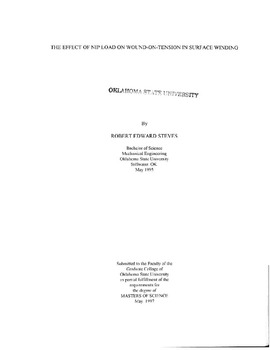| dc.description.abstract | Several products are produced in the form of a web. The webs are wound on a core, so they can be shipped to other manufacturers. These manufacturers will unwind and rewind the web through different processes. There are several configurations used in winding webs, such as center winding, center winding with a lay-on nip roller, and surface winding. A web is a continuous thin flexible material. Most webs are stored in the form of a roll. This study deals with surface winding exclusively. A single roll is first made from raw materials. That roll might be unwound, coated, and rewound. The same roll might then be unwound, printed, and rewound. The web may be printed on through several processes. After printing, the web could be cut and staked like newspapers. Several different companies may wind and unwind a single roll. Since the roll must be wound several times, the integrity of the roll must remain high. A nip roller which impinges the winding roll is often used to reduce air entrapment in rolls wound of impermeable webs. The nip roller also can serve to increase the wound-on-tension in the outer layer of a winding roll. Increasing wound-on-tension by a nip is a practical solution to improving roll quality. The tension induced by the nip increases the wound-on-tension above and beyond the tension seen by the web in the web line. When center winding with a lay-on roller. The higher wound-on-tension is produced from what is called nip induced tension (NIT). The rolling nip serves to cause the outer layers of the winding roll to slip on those layers beneath. For center winding with an impinging nip, the effect of the nip on the wound-in-tension and the radial pressures produced, thereby, are well known. Surface winding and center winding, with an impinging nip roll, look very similar in terms of the winding machinery. The difference is that all center winders apply torque to a core and the web winds up upon the core whereas surface winders apply the torque to the impinging nip and the core free wheels. Empirical evidence has shown that the internal stresses produced within rolls wound by center winding are very different than the stresses produced by surface winding. The objective of this research is to determine why rolls wound by surface winding methods are so different from those wound by center winding methods. | |
